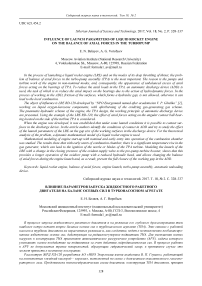Influence of launch parameters of liquid rocket engine on the balance of axial forces in the turbopump
Автор: Belayev E.N., Vorobyev A.G.
Журнал: Сибирский аэрокосмический журнал @vestnik-sibsau
Рубрика: Авиационная и ракетно-космическая техника
Статья в выпуске: 2 т.18, 2017 года.
Бесплатный доступ
In the process of launching a liquid rocket engine (LRE) and on the modes of its deep throttling of thrust, the prob- lem of balance of axial forces in the turbo-pump assembly (TPA) is the most important. The reason is the pumps and turbine work of the engine in non-nominal modes, and, consequently, the appearance of unbalanced excess of axial forces acting on the bearings of TPA. To reduce the axial loads in the TPA, an automatic discharge device (ADD) is used, the task of which is to reduce the axial impact on the bearings due to the action of hydrodynamic forces. In the process of working in the ADD, friction of the surfaces, which forms a hydraulic gap, is not allowed, otherwise it can lead to the local combustion. The object of influence is LRE RD-120 developed by “NPO Energomash named after academician V. P. Glushko” [1], working on liquid oxygen-kerosene components, with afterburning of the oxidizing gas-generating gas scheme. The pneumatic-hydraulic scheme of the engine, the TPA design, the working principle of automatic discharge device are presented. Using the example of the LRE RD-120, the effect of axial forces acting on the angular contact ball bear- ing located on the side of the turbine TPA is considered. When the engine was developed, it was established that under some launch conditions it is possible to contact sur- faces in the discharge device. In the article authors identify the conditions of contact in ADD and try to study the effect of the launch parameters of the LRE on the gap size of the working surfaces in the discharge device. For the theoretical analysis of the problem, a dynamic mathematical model of a liquid rocket engine is used. Mathematical modeling of engine start-up with nominal and early entry into operation of the combustion chamber was studied. The results show that with early starts of combustion chamber, there is a significant temperature rise in the gas generator, which can lead to the ignition of the nozzle or blades of the TPA turbine. Modeling the launch of the LRE with a change in the closing pressure of the oxidant supply valve to the pre-pump turbine booster, shows that this provides a longer operation of the oxidizer pump with a reduced hydraulic head, and allows changing the balance of axial forces during the engine launch and, as a result, prevent the full closure of the working gap in the ADD.
Liquid rocket engine, balance of axial forces, engine launch, turbo-pump assembly, automatic unloading device
Короткий адрес: https://sciup.org/148177705
IDR: 148177705 | УДК: 621.454.2
Текст научной статьи Influence of launch parameters of liquid rocket engine on the balance of axial forces in the turbopump
Introduction. In the process of developing new liquid rocket engines by construction departments and research organizations many problems of constructional, technological, industrial and experimental character are ought to be solved. One of them is to provide the high efficiency and safety of turbo-pump assembly operation during the working and guarantied engine’s functional period. It was proved in practice that final adjustment of powerful engines is the most difficult problem of safe turbo-pump assembly operation and it is necessary to unload the angular contact bearings from axial forces acting on them.
In the process of launching a liquid rocket engine (LRE) and on the modes of its deep throttling of thrust, the problem of balance of axial forces in the turbo-pump assembly (TPA) is the most important. It is connected with the fact that on the design stage of TPA the calculations of balance of axial forces are usually done for the nominal engine operation condition. The value of axial forces in the process of launching a liquid rocket engine depends on TPA rotor angle speed; regime parameters of engine’s operation that are much higher in modern LRE; values of fuel components leakage especially on the shaft from the pump cavity in the direction of turbines; principle of engine start and others. These points prove the importance and complexity of the problem of axial forces minimizing that influence angular contact bearings at the launching phase in order to enlarge their operational period.
Setting up the problem . One of the first test flight of LV Zenit failed due to improper operation of LRE second stage of RD120 (fig. 1.) During the engine launch stage in the cavity between oxidizer pump and the turbine of TPA the burning appeared. Several versions of the fire cause were suggested. One of the main causes was a possible shut of the working gap in automatic unloading device of axial forces that resulted in steel surfaces friction. The version was proved both by the fire point and data of fault detection of finishing engines. After firing test of engines and their disassembly in some of them on mating surfaces of ADD that compose the working gap of the automat were found some tarnishing that proves a short contact of working surfaces in ADD.
How to avoid the possibility of contact of mating surfaces in ADD was the main question. It was obvious that at the launching stage of RD-120 engine there was a need to change the balance of axial forces in TPA between the oxidizer-pump and the turbine. As a consequence the production time of LV Zenit could significantly change. The modifying of force diagram would require to change the construction scheme of mating oxidizer-pump and the turbine, reconstruction of TPA, conduction of hydraulic testing and on-land working out with fire testing of the engine etc. The aim was to find the solution that would exclude the contact in ADD at the launching stage of engine without reconstruction of TPA and replay mode of the engine on firing stand.
ADD construction. The construction of TPA LRE RD-120 (fig. 2) presents the oxidizer pump location, the turbine and automatic unloading device of axial forces that helps to minimize axial loads on angular contact bearing. Shaft bearings (angular contact bearing 2 and angular bearing 4) of TPA are installed in a special hub 7 and work in the oxygen flow that specially fed by the gap between the hub and the turbine starter. Oxygen fed to cool the bearings is taken at the outlet of pump pressure line O (fig. 3, 4). After cooling of angular contact bearing oxygen passes to automatic discharge device, then passing through the angular bearing comes to the disk area of impeller. From this area on specially drilled guides in the pump cover the oxygen accumulates in the collector and then by means of pipeline goes to output area of BPA O.
To reduce the axial force on angular contact bearing the automatic discharge device is used (fig. 5). Its parts are hub 1, sealed in the hub copper graphite ring 3 (inserted later) and disk 2.
Surfaces on the ring and the disk make a variable frontal working gap δАDD. The gap divides the cavities of high р 1 and low pressure р 2 . With the appearing of axial force R (directed to the turbine) the rotor moves and the gap size δ АDD in ADD will decrease. In this case the pressure р 1 rises as the pressure lost at transfer of fluid through the gap into ADD will rise. This increase the axial force F АРУ inversely directed (towards the opening of a working gap) on the discharge device and the rotor will tend to return to the base state.
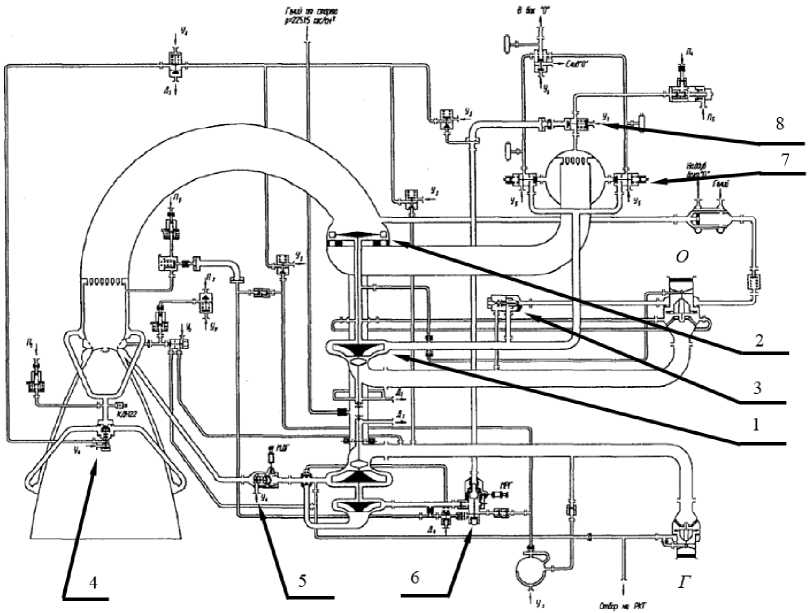
Fig. 1. Pneumatic hydraulic scheme LRE RD-120 [1–8]:
1 – оxidizer pump; 2 – TPA turbine; 3 – cut-off valve of oxidizer feed to BPA; 4 – fuel valve of CC; 5 – fuel throttle; 6 – volume regulator; 7 – supply valve oxidizer to GG; 8 – valve of fuel feed to GG
Рис. 1. Пневмогидравлическая схема ЖРД РД-120 [1–8]:
-
1 – насос окислителя; 2 – турбина ТНА; 3 – клапан перекрытия подачи окислителя к турбине БНА;
-
4 – клапан горючего КС; 5 – дроссель горючего; 6 – регулятор расхода; 7 – клапана подачи окислителя в ГГ; 8 – клапан подачи горючего в ГГ
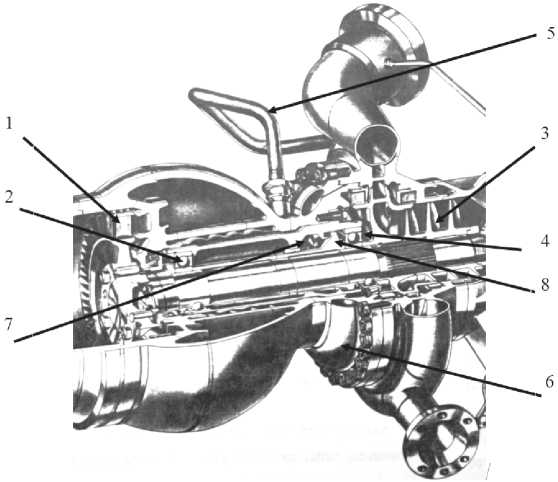
Fig. 2. The construction of TPA LRE RD-120: 1 – turbine; 2 – angular contact bearing; 3 – oxidizer pump; 4 – angular bearing; 5 – inlet of oxidizer for cooling of bearings; 6 – inlet of oxidizer after cooling of bearings; 7 – ADD hub; 8 – ADD disk
Рис. 2. Конструкция ТНА ЖРД РД-120: 1 – турбина; 2 – радиально-упорный подшипник; 3 – насос окислителя; 4 – радиальный подшипник; 5 – вход окислителя для охлаждения подшипников;
6 – выход окислителя после охлаждения подшипников; 7 – втулка АРУ; 8 – диск АРУ
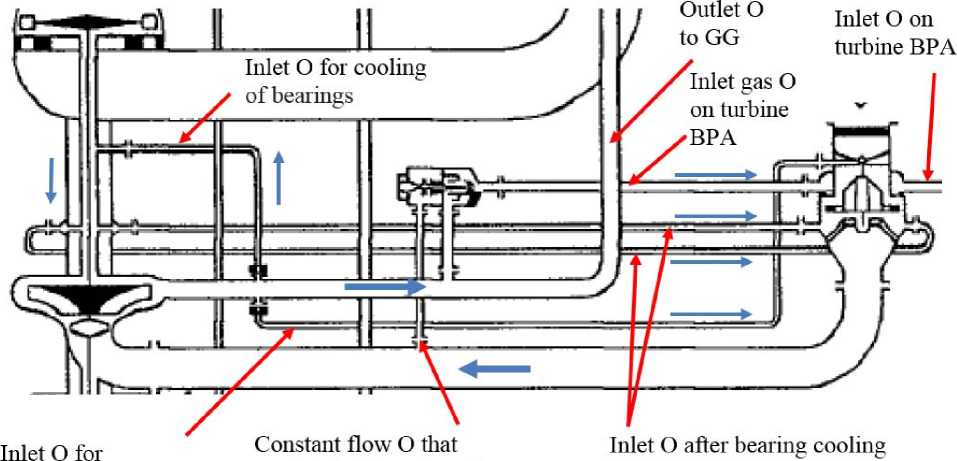
discharging of axial exclude Md UP stoPs 111 forces in ВРА ^е Valve after its closing
Fig. 3. The scheme of oxidizer motion on the way “pump O – BPA O”
Рис. 3. Схема движения окислителя по тракту «насос О – БНА О»
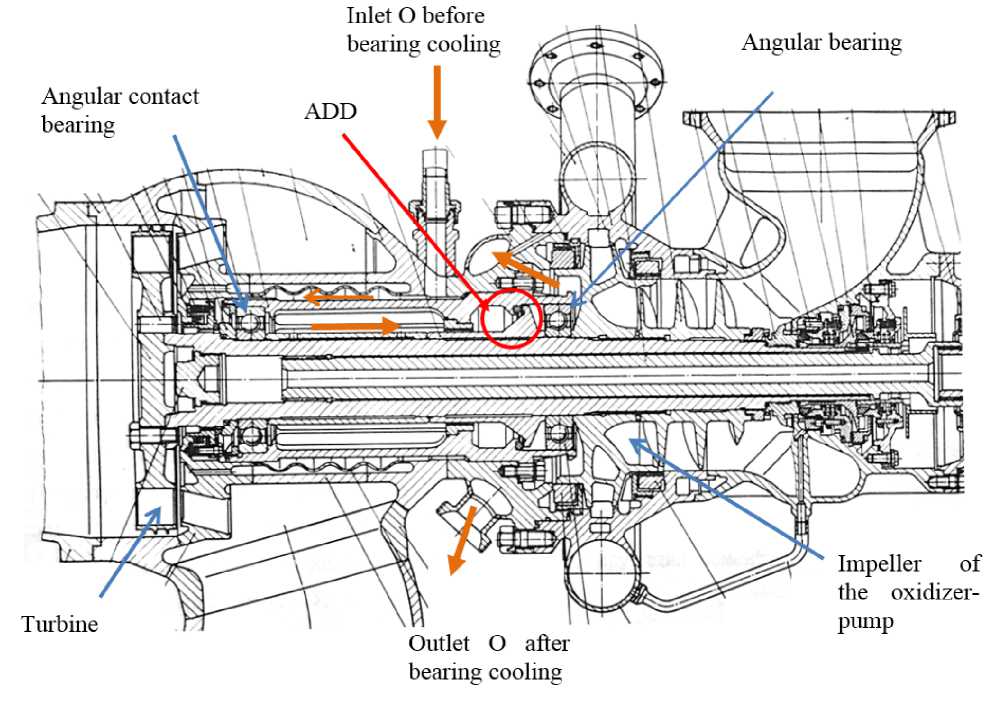
Fig. 4. The part of construction of TPA LRE RD-120 with a scheme of oxidizer motion
Рис. 4. Конструкция части ТНА ЖРД РД-120 со схемой движения окислителя
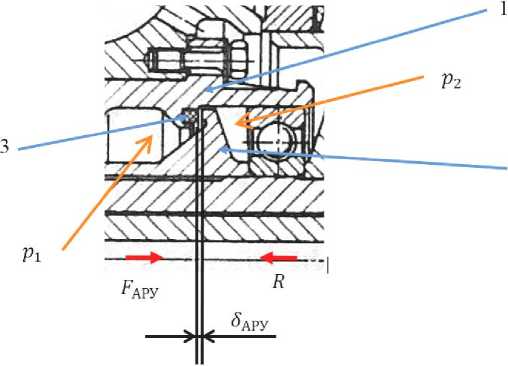
Fig. 5. The construction of ADD TPA LRE:
1 – hub; 2 – ADD disk; 3 – copper graphite ring
Рис. 5. Устройство АРУ ТНА ЖРД: 1 – втулка;
2 – диск автомата разгрузки; 3 – меднографитовое кольцо
The conditions of LRE launch. At the launching phase of LRE RD-120 (fig. 1) the axial motion of the rotor to one or another way mostly detected by the temp and the value of pressure change on the outlet of oxidizer pump impeller and the pressure change on the outlet of the turbine (fig. 4). The rise of both pressures in the launching stage of engines is detected by principle of starterless ignition of the engine conducted according to the scheme “gas – fluid” [9].
First of all the starterless ignition of LRE conducted according to the scheme with post-combustion of oxidizer in the combustion chamber is made by the initial start of gas generator and the next (some time later) start of CC (combustion chamber) work that is characterized by the intense rise of pressure in it connected with the feed of most part fuel to CC. During this phase on TPA turbine grate excess power is realized. It lets the TPA rotor to gain high level rpm and transform the work of pumps from negative to positive heads. At the initial start of engine the pumps work as a source of hydraulic loss as they do not rotate at first. At this time period axial force goes from the pump to the turbine and TPA rotor motion directed to closing of the gap in ADD.
At second, during all the process of engine launching, it is important to avoid the appearance of temperature perturbation in GG that in oxidizing medium can lead to the firing in turbine tract. One of the reasons of such perturbations in GG is CC (combustion chamber) starting to work and as a result the pressure rise at output of the turbine, falling of excess power, braking of the TPA rotor acceleration and braking of oxidizer consumption. In LRE RD-120 at launching phase of GG the fuel fed with the rise of consumption through the regulator (fig. 1, p. 6) on strict program, so braking of oxidizer consumption leads to decreasing of coefficient components relation in GG and consequently to the rise of oxidizing gas temperature. If the CC starts working early, there will be a great gas temperature perturbation in GG.
The time of CC starting to work is detected by: the moment of main fuel valve opening (fig. 1, p. 4) (relative to oxidizer valve and GG fuel (fig. 1, p. 7, 8)) in feeding line to CC; the value of hydraulic losses of the pressure on throttle of fuel (fig. 1, p. 5); the time of starting and the speed of its switching from the starting position to nominal (at launching phase of LRE RD-120 throttle of fuel put in the position that makes the pressure losses about 10 times more than at nominal regime of engine work with the following its opening in the position that provides nominal coefficient of relation between fuel components in CC); the depth of vacuumizing of engine’s fuel cavities before the filling that influence on the final value of gas bubbles in the engine’s fuel cavities; the value of fuel pressure at inlet of engine etc.
This principle without running the starter is used in many liquid rocket engines, for example in RD-256, RD-301, RD-170, RD-180 and others.
The starting to work of CC in RD-120 engine, leads to the increase in pressure at the outlet of the turbine TPA, and consequently to the increase in axial force directed towards the disclosure of the working gap in ADD.
Modeling of running LRE RD-120 with early entry into work of CC. In the process of development of rocket engines RD-120, JSC “NPO Energomash named after academician V. P. Glushko”, together with the Moscow Aviation Institute and other research organizations are constantly carried out mathematical modeling of the various processes occurring in the engine, which allowed to solve many problems arising in the process of development of this engine [10].
Different mathematical models were developed for the theoretical study, in particular in the MAI, together with NPO Energomash they developed a nonlinear mathematical model to study the launch of the RD-120 engine, which later was modified, in the part connected with studying the behavior of the axial forces in the TPA of this engine. This model was based on theoretical background provided in [11–13], generalized data of pumps oxidizer flow test and purging the turbines, supplemented by a differential equation of the displacement of the rotor. The model takes into consideration the effect of not only static forces in the respective area, but also dynamic components, in particular the action of dynamic pressure of the gas over the turbine blades, after gas outflow from its nozzle, the mass of the floating rotor etc [14]. In the case when the rotor occupies a position in which a portion of the axial force begins to perceive angular contact ball bearing, bearing load characteristics start working [15].
With the help of mathematical model developed to study the RD-120 engine start, even before the accident mentioned above, it was stated that in the course of its run, with an early start to the work of the CC, in its GG there is a perturbation in the temperature of the oxidizing gas of great value. Such changes in temperature can lead to fire of structural elements of the engine, and at first flow path of the turbine TPA.
Fig. 6 and 7 show the results of the start model engine (similar to the RD-120 engine and the main parameters close to the parameters of this engine), with the different time of command to open the fuel valve installed on the inlet of the cooling path of the CC. The figures demonstrate the change in the process of starting the engine in a relative way of temperature oxidizing gas in GG, the pressure in the CC and the speed of the rotor TPA (scale on left axis 0–1) and the change in the value of the working gap in ADD (scale right axis 0–0.12 cm).
It should be noted that while mathematical modeling the resulting temperature of the gas in GG is mass average, i. e. averaged for the entire volume. The results of measurements of the temperature showed that in the process of starting the engine there is quite a large “delamination” on a diametrical section of GG. One of the tempera- ture sensors in the process of starting the engine can log high temperature “straps” while others may show low temperatures. Therefore, the analysis of modeling results and decision-making, this fact must be taken into account.
The results of modeling show that at the early start of the CC to work (associated with the coming of the primary fuel in it) there is a significant temperature spike in GG that can cause a fire in the nozzle or blades of the turbine TPA.
So, this way, which could change the balance of the axial forces, when the engine starts running is not acceptable.
Modeling of rocket engine startup with a change in the value of the closing pressure of the valve for feeding the oxidant to the turbine BPA O in order to accelerate the motion of its rotor. Conducted modeling of various actions (changing the initial setting of the throttle of fuel; the time of giving the command to the fuel valve of the CC; change the initial settings of the flow controller, its speed and the beginning of resetting etc.) that do not lead to the resumption of testing of the engine, did not give a positive result. Specialists on mathematical modeling proposed to change (increase) pressure of closing the valve of the oxidant in the pipeline of its supply to the turbine BPA O providing fast acceleration of its rotor. It would seem like this action could change the balance of the axial forces in the TPA, in the process of starting the engine to prevent complete closing of the working gap in the ADD, or at least reduce the magnitude of the axial force directed to move the rotor in the direction of closing this gap?
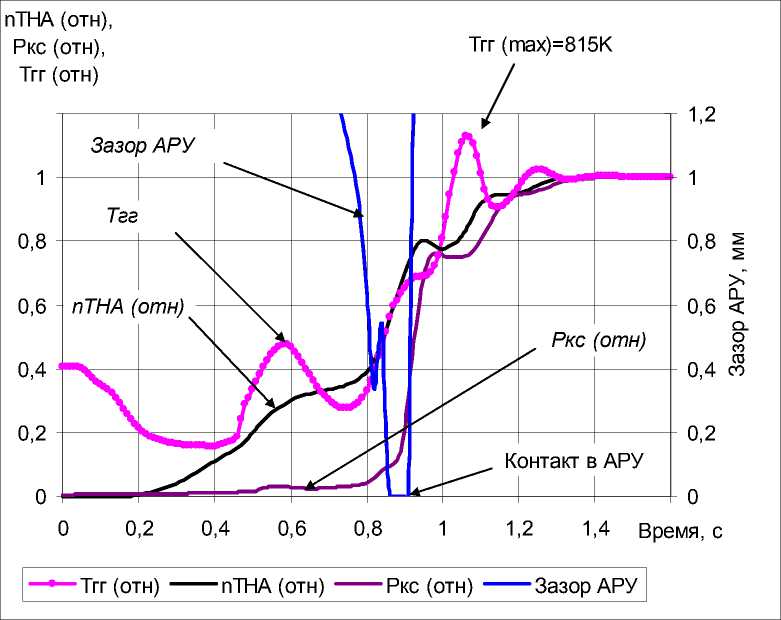
Fig. 6. The dependence of the changes of basic parameters during normal cyclogram launch
Рис. 6. Зависимость изменения основных параметров при штатной циклограмме запуска
nTHA (отн),
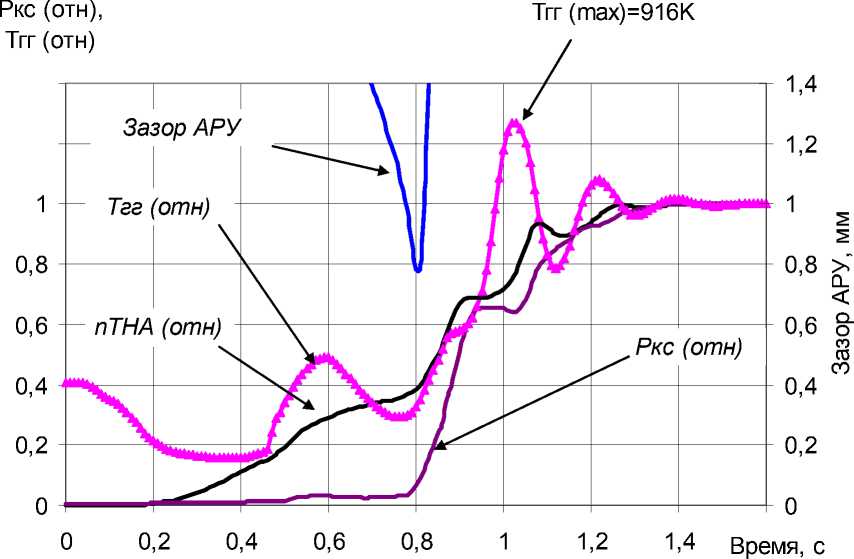
* Tгг (отн) ^^^^^^^е nTHA (отн) ^^^^^^^е Pкc (отн) ^^^^^^^е Зазор АРУ
Fig. 7. The dependence of the main parameters in the standard sequence diagram of starting the engine (except for the time a command for opening the valve to supply fuel to the CC – it is done 0.2 sec earlier)
Рис. 7. Зависимость изменения основных параметров при штатной циклограмме запуска двигателя (за исключением времени подачи команд на открытие клапана подачи горючего в КС – команда подана ранее на 0,2 с)
The results of mathematical modeling showed (fig. 8) that this action can significantly reduce the axial force, directed to closing the gap in ADD in the process of starting the engine.
First of all, this action provides a longer operation of the oxidizer pump with low pressure due to the greater pumped consumption, because the consumption of the oxidizer supplied to the drive turbine of TPA returns to the main pump (i. e. loop) and a smaller speed of the rotor TPA, due to longer loading of the pump. In regular version of closing the valve, the speed of the rotor TPA rise immediately after the closing of this valve (by reducing the power consumption of the oxidizer pump, through a reduction in the quantities pumped by the pump flow), and at higher pressures of its closure, the increase of the speed of the rotor for the same reason, happens later (fig. 9). Thus, there is a period of time (between the times of closing the valve at normal and higher closing pressure) during which the speed of the rotor TPA, the greater the closing pressure of the valve, will be less than in the same period of time during normal closing pressure. And the axial force aimed at closing the working gap in ADD, directly connected with the value of the pressure of the oxidizer pump, which is proportional to the speed of the rotor TPA.
Secondly, the valve oxidizer in the line of the fast acceleration of the rotor BPA O at higher pressures while closing is shut later, thus it is bringing the lifetime of low pressure on the pump oxidizer to the time of the entry of the CC to work.
Thus, the increase of pressure of the valve of the oxidant closing in the line of fast acceleration of BPA O, allows to change the balance of the axial forces in the process of starting the engine and prevent full closure of the working gap in ADD or at least to reduce the magnitude of the axial force aimed at closing this gap.
The outcome of the work on the problem of changes in the balance of the axial forces and preventing the closing of the working gap in ADD, in the startup process of the RD-120 engine was the two main actions – the change (increase) of the pressure of closing the valve of the oxidant in the line of an accelerated dispersal of BPA, and the change of hub material (which is associated with radial-thrust and radial bearings) from steel to bronze. The first action provides at least a reduction of the axial force aimed at closing the working gap in ADD, in the process of starting the engine RD-120, and the second is the exclusion of fire in possible short-term contact of friction pairs in ADD.
nTHA (отн),
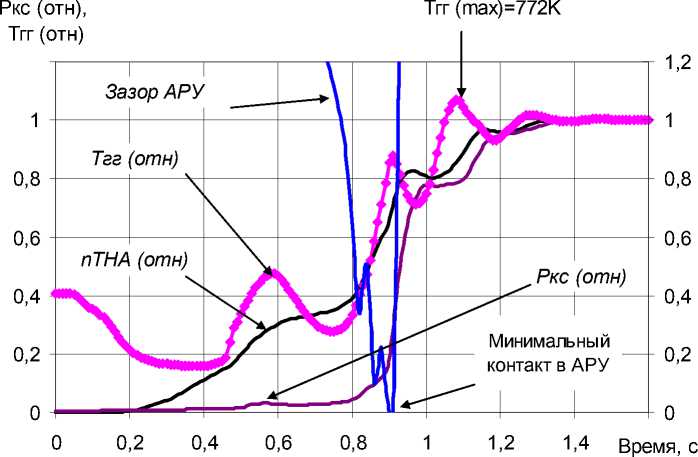
Tгг (отн) nTHA (отн) Pкc (отн) Зазор АРУ
Fig. 8. The dependence of the main parameters in the standard sequence diagram of starting the engine and up to 40 ATM pressure closing valve in the pipeline of fast acceleration of BPA
Рис. 8. Зависимость изменения основных параметров при штатной циклограмме запуска двигателя с увеличенным на 40 атм давлением закрытия клапана в магистрали ускоренного разгона БНА
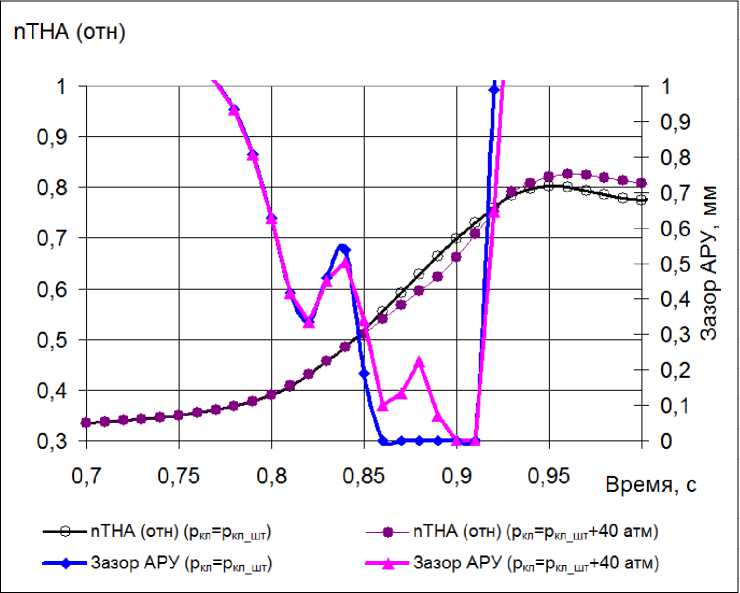
Fig. 9. Comparison of the change in the value of the gap in ADD and the dimensionless frequency of rotation of the rotor TPA between regular (reg) version and a launch with a big closing pressure (reg+40 ATM) of the flow valve O to the turbine BPA O
Рис. 9. Сравнение изменения величины зазора в АРУ и безразмерной частоты вращения ротора ТНА между штатным (шт) вариантом запуска и случая с большим давлением закрытия (шт+40 атм) клапана подачи О на турбину БНА О
Conclusion. This work discovers the influence of various factors on the balance of the axial forces in TPA LRE RD-120. It is shown that under certain conditions in the run mode contact of the mating parts in the design of the ADD is possible. Considered activities would exclude this contact without changing the design of the TPA and the restart of testing of the engine.
One of such activities could be an earlier entry into the work of the CC, but in this case significantly increases the temperature of gas splash in GG, which may result in an oxidizing atmosphere to fire of elements of the flow path of the turbine.
The variant of launching the rocket engine with increased closing pressure of the flow valve O to the turbine BPA for the accelerated dispersal of its rotor is presented. It is shown that this allows to change the balance of the axial forces and to prevent complete closing of the working gap in the ADD, or at least to reduce the axial force aimed at closing this gap.
The works on mathematical modeling of the launch of the RD-120 engine reaffirmed the need for the development of modern mathematical models of liquid rocket engines, which allow as looking into the future of the developed engine, and in critical situations to find the best solution to arising problems.
Список литературы Influence of launch parameters of liquid rocket engine on the balance of axial forces in the turbopump
- РД-120 . URL: http://www. npoenergomash.ru//dejatelnost/engines/rd120/rd120_4.html (дата обращения: 24.04.2016).
- Katherine Van Hooser, John Bailey, Alok Majumdar. Numerical prediction of transient axial thrust and internal flow in a rocket engine turbopump. AIAA-99-2189. . URL: https://gfssp. msfc.nasa.gov/zip/paper4_aiaa99_2189.doc (дата обращения: 01.05.2017).
- Single-Shaft Turbopumps in Liquid Rocket Engines. AIAA 2006-4377/Y. Demyanenko . URL: www.rocket-propulsion.info/resources/../AIAA-2005-3946 (дата обращения: 01.05.2017).
- Internal flow and axial balancing of a Rocket pump. AJK2011-06027/Takashi Shimura //Proceedings of the ASME-JSME-KSME 2011 Joint Fluids Engineering Conference. AJK-Fluids, 2011. 10 с.
- Шерстянников В. Исследование динамики роторов ТНА ЖРД . URL: http://engine.aviaport.ru/issues/24/page18.html (дата обращения: 01.05.2017).
- Чванов В. К., Фатуев И. Ю., Беляев Е. Н. Двигатель 11Д123. Расчет динамический. Ч. 1. Расчет параметров двигателя при запуске. 00.1723.0000.0000.06. 0P05. 2001.
- К уникальным разработкам . URL: http://epizodsspace.airbase.ru/bibl/kb-ujn/05.html (дата обращения: 19.01.2016). Авиационная и ракетно-космическая техника
- Фатуев И. Ю. Исследования проблем, связанных с модификацией двигателя РД-120 для первых ступеней ракет-носителей коммерческого назначения: дис. … канд. техн. наук: 05.07.05. М. 2003. 182 с.
- Основы теории и расчёта жидкостных ракетных двигателей/А. П. Васильев /под ред. В. М. Кудрявцева. 2-е изд., перераб. и доп. М.: Высш. шк., 1975. 656 с.
- Математическое моделирование современных ЖРД/Б. И. Каторгин //Двигатель: науч.-техн. журнал. 2002. № 4. С. 13-15.
- Добровольский М. В. Жидкостные ракетные двигатели. М.: МГТУ им. Н. Э. Баумана, 2006. 488 с.
- Конструкция и проектирование жидкостных ракетных двигателей: учебник для студентов вузов/Г. Г. Гахун . М.: Машиностроение, 1989. 424 с.
- Компьютерные модели жидкостных ракетных двигателей/Е. Н. Лебединский . М.: Машино-строение, 2009. 375 с.
- Овсянников Б. В., Боровский Б. И. Теория и расчет агрегатов питания жидкостных ракетных двигателей. 3-е изд., перераб. и доп. М.: Машино-строение, 1986. 376 с.
- Беляев Е. Н., Чванов В. К., Черваков В. В. Математическое моделирование рабочего процесса ЖРД. М.: МАИ, 1999. 226 с.

